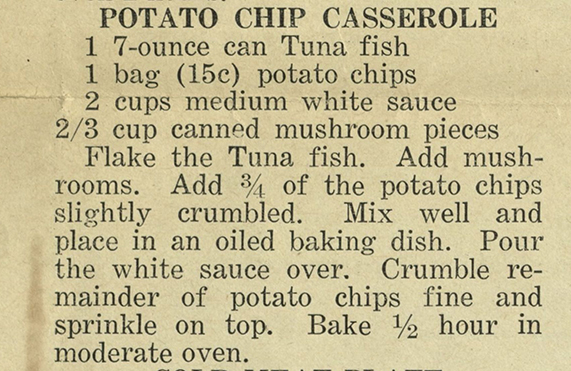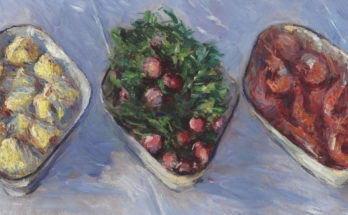Potato Chip Casserole became a popular mid-century modern recipe in part due to the efforts of Katharine Howes Schultz, a dedicated home economics teacher in La Crosse, Wisconsin. In addition to teaching at La Crosse Vocational School’s Home Economics Department, Katharine represented the school as a WKBH radio host, sharing the recipe in a 1938 broadcast of “Cooking School of the Air,” marking one of the earliest revivals of this dish. Also known as Tuna Fish Casserole, Potato Chip Casserole reached its peak popularity in the 1950s, serving as a staple dish for GI Generation mothers who prepared it for their growing Baby Boomer children.
Three years after Katharine Schultz’s radio show, the 1941 edition of The Sexton Cook Book published the recipe for large-scale institutional meals in schools and hospitals, where it became an integral part of the American palate.
But where did this Tuna Fish Casserole, or Potato Chip Casserole, originate? It appears to have roots in government publications. In 1912, a recipe for Tuna Fish Casserole was included in Purdue University’s Department of Agricultural Extension Bulletin, Issues 243-270, USDA. The 1912 recipe: “Tuna Fish Casserole (Serves 6): 1 can tuna fish (7 ounces), 1 small bag of potato chips, and 1 can of mushroom soup.”

The early recipe varied slightly from Mrs. Schultz’s 1938 version, pictured here. While the 1912 recipe suggested using canned mushroom soup, Mrs. Schultz’s approach involved making a white sauce from scratch before adding canned mushroom pieces. As part of a domestic science cooking program, the effort behind the homemade white sauce added depth to the dish. I can vouch for Mrs. Schultz’s mix; it was fun to prepare and though I didn’t prefer it when a child, this 1938 recipe surprisingly yielded delightful results.
For some, making white sauce is a breeze—something a recent comment on my white sauce video [link to YouTube] pointed out. But everyone starts somewhere! Mrs. Schultz taught her students how to make white sauce because it’s an elementary skill, and the first time can really feel like an adventure. I can definitely relate!
Katharine completed 5 years of college, perhaps from the Normal School in La Crosse. She was born 1892 in Wisconsin and would have been 20 years old when the recipe was first published only 400 miles away at Purdue. Katharine married Reinhold Schultz in 1920, also Wisconsin-born, as was his father, and his mother was born in Germany. In 1925 they had a son, William–named after Katharine’s brother who was assistant General Post Master of the United States. In 1935 Katharine and her husband lived at 1228 Madison St in La Crosse, just 3 miles from where she taught home economics, now Western Technical College. The school changed their name through the years.
In 1938 Katharine was a host on the radio show “Cooking School of the Air” sponsored by her school and WKBH. Their radio brochure announcement was the first instance of the recipe Potato Chip Casserole that I found, pictured here, although now I realize that it was a recipe in circulation since she was a young woman.
Here’s a little more about Katharine’s life, and the WWII mystery about her husband, Reinhold. In 1940, Mrs. Schultz was living at 2326 Madison St with her son and a live-in maid. Katharine’s husband “has been taken at camp,” perhaps meaning a military camp? Likely. Or the US government detained him as a German national and he lived at an internment camp under the Alien Enemies Act? Less likely. Reinhold was a US citizen, with a German mother, and a very German name. During WWII there had been only 11,000 German Americans interned — compared to how many German-Americans there were in the US in 1940, this was “a drop in the bucket,” as that generation would say. 1940 is early for WWII. Could Reinhold Schultz have just been enlisted at a military camp? Yes, this was likely. In 1940 there was the first peacetime draft in the country’s history. During WWI it was said Reinhold was a Captain at Camp Culver, and in 1919 led a cargo of $2 million in supplies to trade with Russia. For decades after he had roles of leadership in government work, along with being an Alderman. In 1930 he was a superintendent of the public employment office, and near retirement in 1950 he was a Hospital Aid for the VA hospital. It’s very likely he was drafted in 1940, leaving his wife with household help as he was “taken to camp.”
Katharine in 1950 continued as a Home Economics teacher at the vocational school, near retirement age, husband finally at her side for 5 more years, living at her same address as 1940. No maid.
Widowed in 1955, and retired, she moved 50 miles east, perhaps to be near a relative. She died at the age of 89, having lived a life of helping others and encouraging many young cooks.
